
NAMMbulating 2016
NAMM Convention January 2016, Anaheim, CA
Page 1 of 3 - Go to the next page ->>>
I did not attend NAMM in 2015 because I was limping badly, and a couple of weeks later, had surgery for a torn meniscus. It was good to get back and walk around, although I didn't see a lot of people that I often see, either by chance or because I was surprisingly focused on this list of things that I had brought with me, which was primarily funny sounding effects pedals and analog synthesizers. As we walked along, Chris and I, who create music as The Mercury Seven, realized that since we had finished up our third album "The Rendezvous, we were in essence walking around NAMM getting inspired by experimental, creative new sounds, whether through new instruments such as the steel tongue drum, odd sounding and inventive effects pedals, or cool new analog synths. |
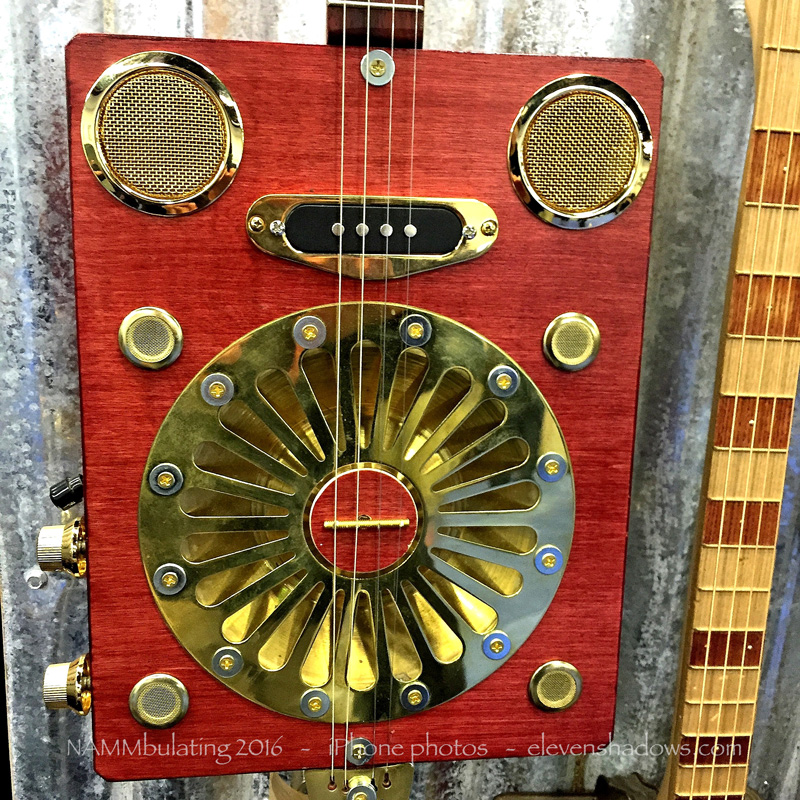 Cigar box guitar.
Cigar box guitar. |
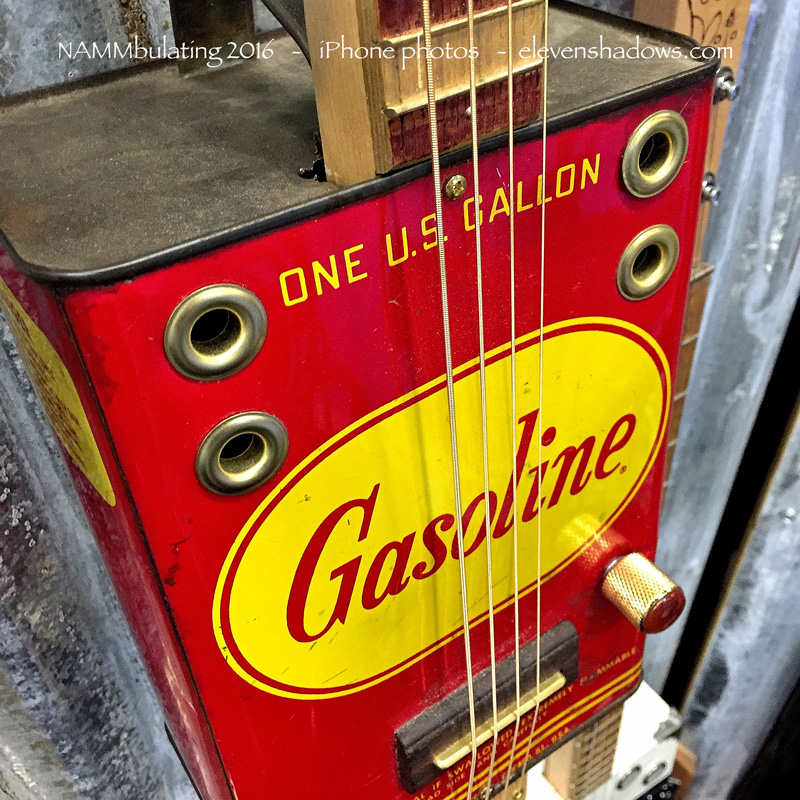 Gasoline can guitar.
Gasoline can guitar. |
"Welcome to the Idiopan steel tongue drum. The first and only steel tongue drum capable of being tuned to 100's of scales from around the world. The Idiopan provides warm, pure tones with an easy to play zig-zag pattern that is fun for novice to the expert musician. The Idiopan allows the ability to transcend rhythm and melody easily within one instrument." |
NAMMbulating 2016 - Idiopan Steel Tongue Drum |
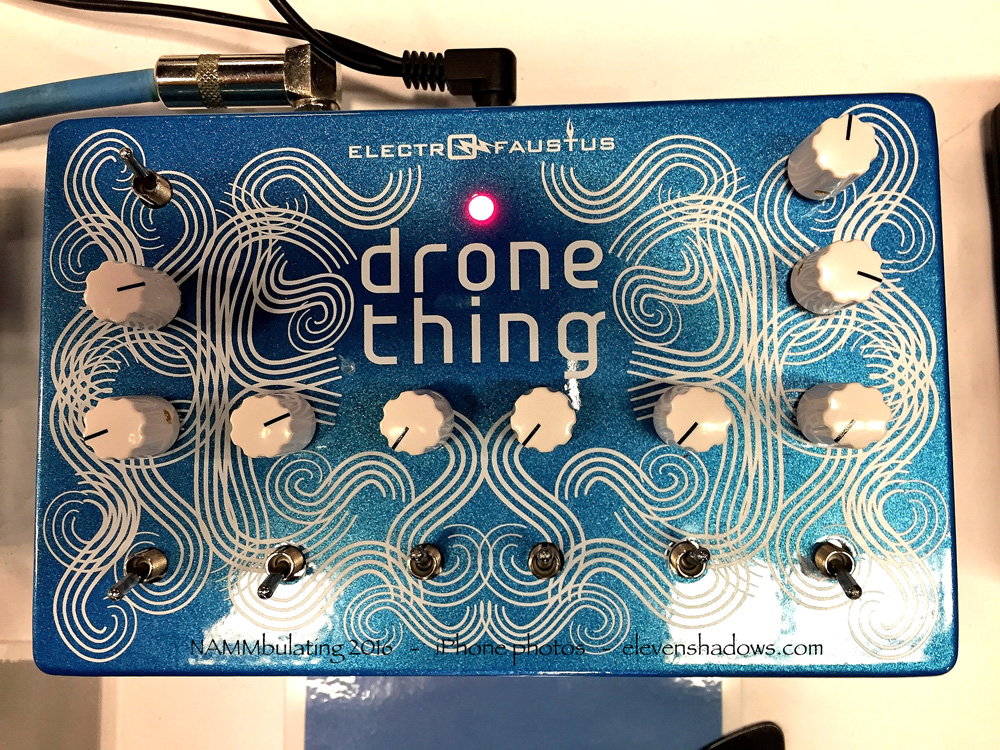 Electro-Faustus Drone Thing, which is completely tunable and does exactly what you think it does: create numerous drones. Electro-Faustus Drone Thing, which is completely tunable and does exactly what you think it does: create numerous drones. |
 Electro-Faustus Blackfly, making fun twangy odd noisy things with springs in an effects pedal. Electro-Faustus Blackfly, making fun twangy odd noisy things with springs in an effects pedal. |
What I liked around the same place was the smallsound/bigsound F*ck Overdrive pedal, which is apparently inspired by William Basinski's The Disintegration Loops. It's an attempt to recreate some of the crackling, disintegrating sounds found on the erecordings, an extremely unique effect unlike any other. Some tones are reminiscent of overdriven tape, torn speakers, an d blown tubes or amp sag. Unfortunately, I never took a photo of it. |
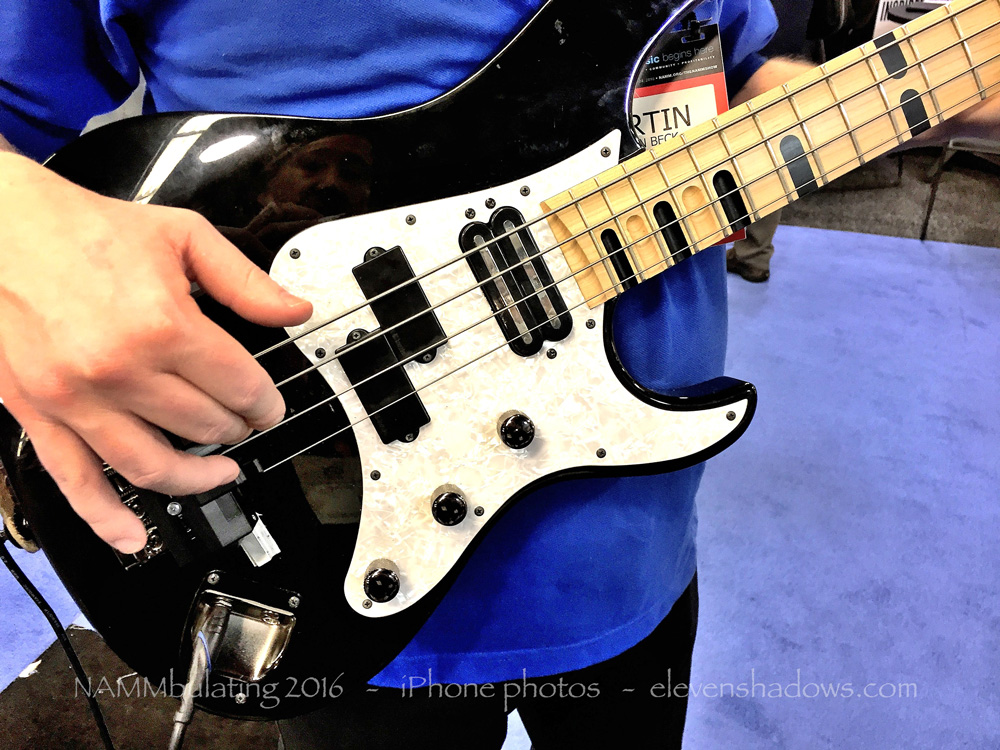
Electro-mechanical bowing device that attaches to the electric guitar or bass, enabling players to produce string sounds such as cello, viola, or violin. You can create endless sustain, haunting drones, or bow polyphonic chord arrangements to entice orchestral sounds from your instrument. Surprisingly, the person claimed not to be familiar with Michael Brook's Infinite Guitar, which had controllable, and if wanted, "infinite" sustain. |
NAMMbulating 2016 - Gizmotron Mechanical Bowing Device |

I played the DDSI/Oberheim OB-6, which had a huge buzz among keyboardists and others at the NAMM show. While I hardly put it through its paces, it was one of those analog synths that sounds good seemingly no matter what you did with it, and sounded good right from the start. Of course, at US$3000 list, it should, especially if two synth luminaries have collaborated. Let's let them describe further: Said Dave Smith: “Tom and I have been friends and friendly competitors since the late 1970’s. Back in the day, people were typically in either the Prophet or the Oberheim camp. Now, with the Prophet-6 out and doing so well, we thought it would be fun to combine our strengths and bring back Tom’s classic polyphonic sound, too — in a modern format.” Added Tom Oberheim: “A lot of people, myself included, have always felt that the SEMs had a certain uniquely big, organic sound unlike anything else. Working with Dave to make that sound widely available again with some modern touches and full programmability has been real a pleasure.” The OB-6 features two discrete voltage-controlled oscillators (plus sub-oscillator) per voice, with continuously variable waveshapes (sawtooth and variable-width pulse, with triangle on oscillator 2). There is a classic SEM-inspired state-variable filter (low-pass, high-pass, band-pass, and notch) per voice. Voltage-controlled amplifiers complete the all-analog signal path. “The classic, bold SEM sound is all there,” said Oberheim. Present also is X-Mod, with filter envelope and oscillator 2 as modulation sources (with bi-polar control). Destinations include oscillator 1 frequency, oscillator 1 shape, oscillator 1 pulse width, filter cutoff, and filter mode. The knob-per-function front panel puts virtually all parameters at a user’s fingertips. Toggling on the Manual switch enables live panel mode, in which the OB-6 switches to the current settings of its knobs and switches. A dual effects section provides studio-quality reverbs, delays (including standard and BBD), chorus, and faithful recreations of Tom Oberheim’s acclaimed phase shifter and ring modulator. The effects are digital, with 24-bit, 48 kHz resolution, but a true bypass maintains a full analog signal path. Additionally, the OB-6 features a multimode arpeggiator and a polyphonic step sequencer with up to 64 steps (and up to 6 notes per step) plus rests. It allows polyphonic keyboard input and can sync to external MIDI clock. The full-size, four-octave, semi-weighted keyboard is velocity and aftertouch sensitive. Said Dave Smith, “As with the Prophet-6, we made size a primary concern on the OB-6. It’s the right mix of power and portability and it fits right in on-stage or in the studio.” Added Oberheim, “And of course, it’s got that unmistakable SEM sound that’s going to turn a lot of heads. ” The OB-6 is manufactured and sold by Dave Smith Instruments. It will be available in March, with a US MAP of $2,999." |
|
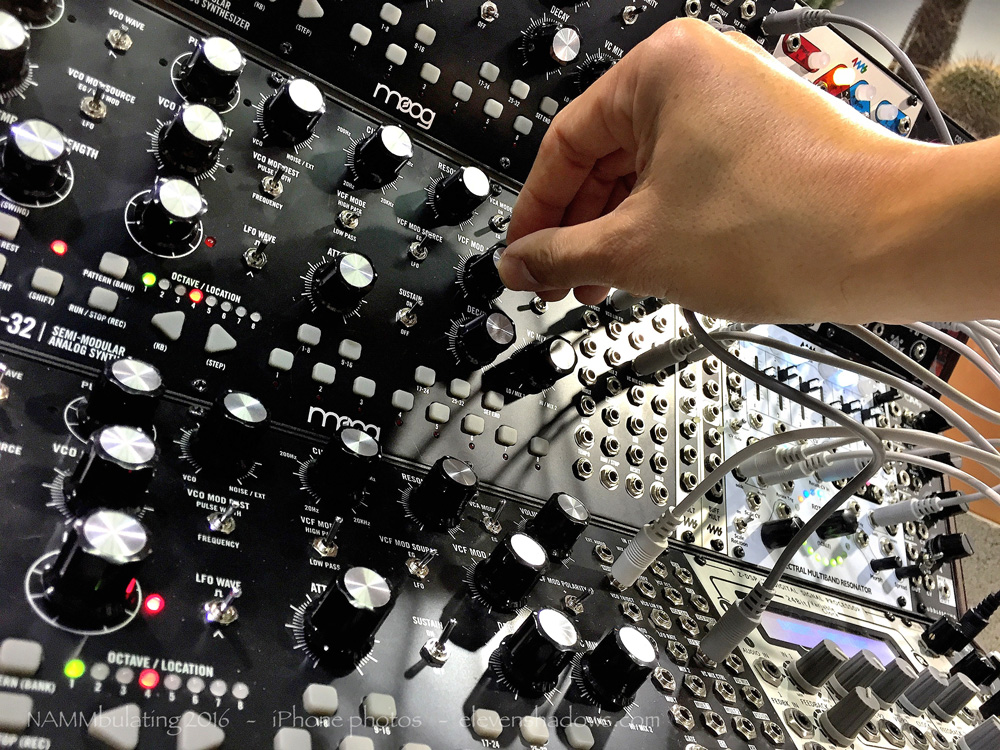 Here's how Moog describes the MOther-332 analog synth: "
Here's how Moog describes the MOther-332 analog synth: "
Moog has unveiled Mother-32, a semi-modular synth that functions both as a standalone unit and a Eurorack module. Much like Roland’s AIRA System-1m, Mother-32 plugs into other CV-enabled gear, but doesn’t require patching to create a sound. Unlike the System-1m, it’s fully analog, has the famous Moog ladder filter and also features a one-knob per function interface, 32-point patchbay and 32-step voltage-controlled sequencer, which stores 64 patterns. While Moog synths are traditionally expensive affairs, Mother-32 will retail at $599. Moog sees the device as being able to form part of a larger Eurorack system or even chain up to other Mother-32 units for an affordable all-Moog modular. The synth is shipping to stores now, but you can watch it in action via the video below." |
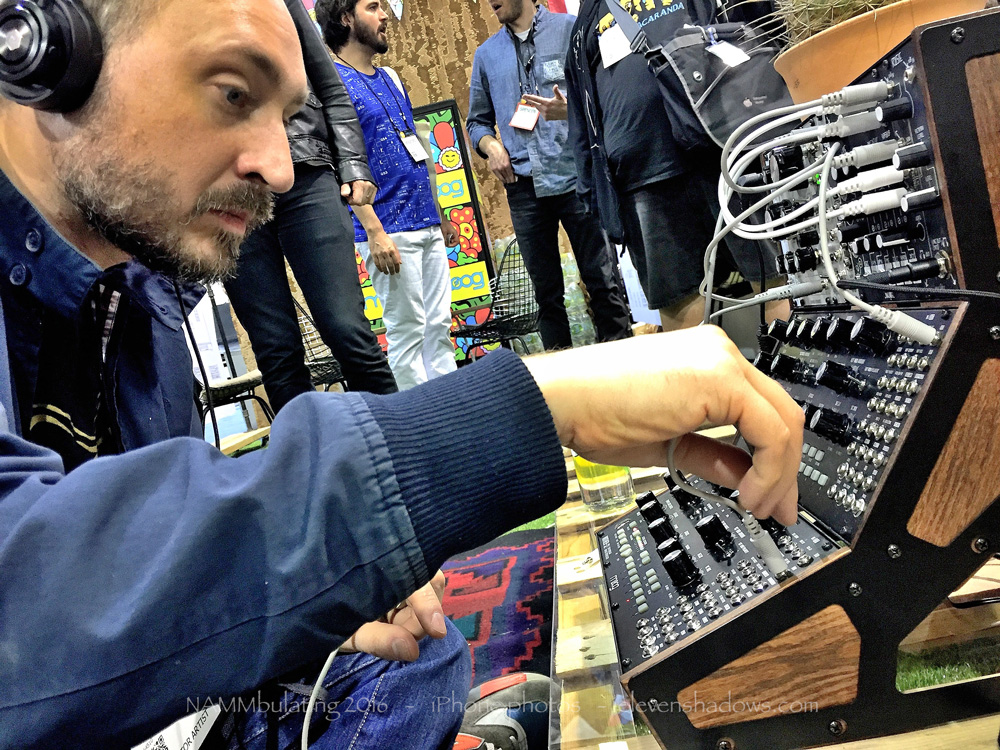 At NAMM in general, there was an enormous cluster of booths, front and center, featuring tons of modular synths from smaller European companies as well as larger ones, analog synths, and associated stuff. It was huge, and a lot of people were talking about it. "Grown-ups" still don't quite understand the allure of it, thinking that it's old stuff that's simply brand-new to a generation of twenty-somethings. But largely what's going on here is that it's a reaction against soft synths. They're physical. They're hands-on. They're actually instruments. They are lots of options. They're cool and fun in a geeky sort of way.
At NAMM in general, there was an enormous cluster of booths, front and center, featuring tons of modular synths from smaller European companies as well as larger ones, analog synths, and associated stuff. It was huge, and a lot of people were talking about it. "Grown-ups" still don't quite understand the allure of it, thinking that it's old stuff that's simply brand-new to a generation of twenty-somethings. But largely what's going on here is that it's a reaction against soft synths. They're physical. They're hands-on. They're actually instruments. They are lots of options. They're cool and fun in a geeky sort of way.And they sound great. Soft synths that emulate analog synths don't hold a candle to the sound. They do not sound a like a real analog synth, and the difference ain't subtle. A hardware analog synth has a temperament, it has character, and it's an instrument. You switch a switch, turn a knob, connect a different thing together, play, push, squeeze, press, whatever, and it plays. It's an instrument. A soft synth. Well. It requires updating. It's on your screen. There's a disconnect. Oh, sure, you can use a controller. Yeah. Wheeee. And it doesn't sound half as good. ?Soft synths have their place. I use them sometimes. I'm not anti-soft synth. But dayam, there's an enormous difference in approach, feel, and sound. |
~~ NOTE: I am actually quite happy to say that it appears like I'm wrong. This does make interesting sounds. Just not by my five minute attempt, apparently. Have a listen: |
|
Ken's photos of Nobel Peace Prize Winner Aung
San Suu Kyi, as well as photos of Peru, Burma, India, Morocco, China, Thailand,
Ghana, Ecuador, and elsewhere, have appeared in many books, magazines,
websites, and galleries. Visit the
Ken Lee Photography Website. Some of Ken's select photos may be
purchased through his
Imagekind Store. |
NAMMbulating 2016 - NAMM Show, Anaheim, CA
Page 1 of 3
Eleven Shadows Travel Page
Contact photographer/musician Ken Lee